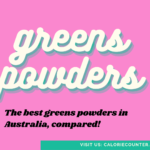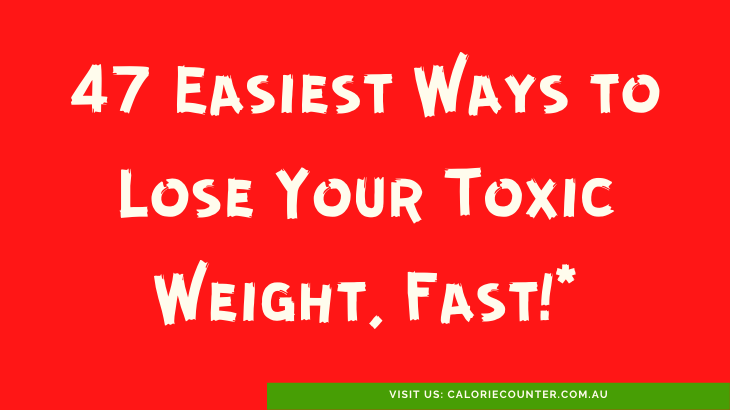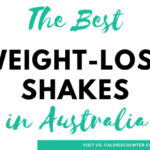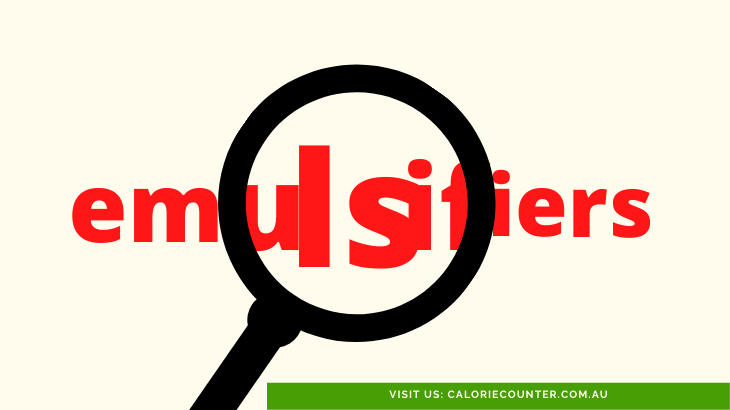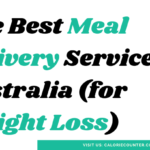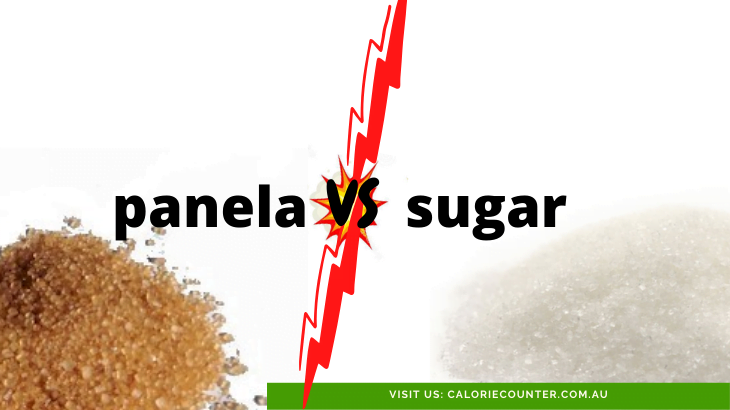Here’s a coffee comparison chart showing the calories in different coffees, some with milk, others without, and several other variations:
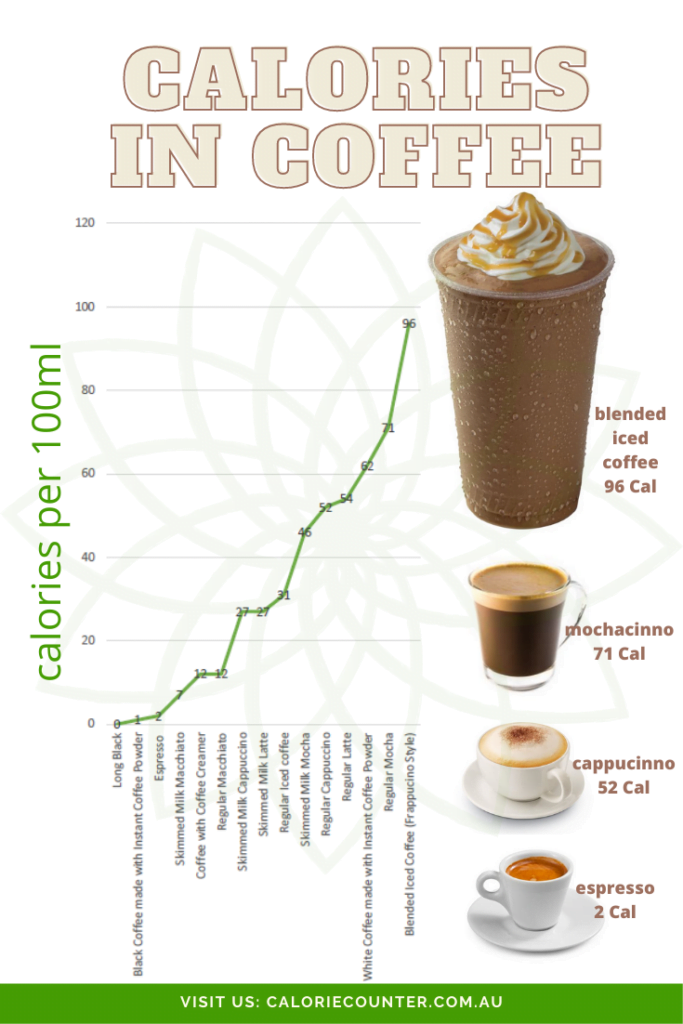
When thinking about calories in coffee, the best approach is to accept that coffee is nothing more than a glorified flavouring for your drink. Sure, it is a super flavour, jam-packed with stimulants, vitamins, minerals and a thousand different chemical compounds, but from a food calorie perspective, it is just a flavouring. In other words, coffee itself does not contain any meaningful calories!
Calories in Coffee come from Milk and Sugar
Thought of in this way, the real question becomes, how many calories are in the drink to which you are you adding your coffee flavour? Add it to plain water, and you get a zero-calorie Long Black. Add it to a caramel milkshake and you get a 500-calorie Frappuccino. Yes, both of theses drinks are called “coffees” at your local café, but minus the coffee flavour they are completely different.
When making coffee at home, most people add about 60ml of full-cream milk and one teaspoon of sugar to a cup of coffee-flavoured water. This converts a zero-calorie coffee and water drink into a 55-calorie coffee, water, milk, and sugar drink. Each teaspoon of sugar adds 16 calories and each 60ml of milk adds about 39 calories.
Soy Coffees have fewer Calories
Wondering what the difference between adding skimmed, lite, soy, and full-cream milk to coffee is? Apart from reduced calories, skimmed milk has the benefit of being low in saturated fat and high in protein. Soy lattes contain about 10% fewer calories than regular lattes. Check out our milk comparison post for a detailed insight.
Calories in Café Coffees
Let’s talk about calories in café coffee. Lattes and cappuccinos, flat whites and espressos, life in Australia would not be the same without them. Here, we are talking about the kind of coffee you get by forcing hot water through tightly packed ground coffee beans, rather than the instant powder or drip filter type.
The good news is that coffee made in the espresso style (when water is pressured through a tight crush of ground coffee beans) is much more nutritious than coffee made in other ways. This is because many small bits of the coffee beans make it through the press basket and into the drink.
Those bean bits hold significant amounts of B vitamins and magnesium in addition to the caffeine and other interesting chemical compounds. If you have the choice between espresso style coffee and others, choose espresso for this reason (and the flavour of course!).
What about calories? What is the most, and least, calorific type of espresso coffee? Here’s your list, taken straight from our website, in order of least to most:
Long Black 0 Calories
The Long Black is made by pouring a double shot of espresso over hot water. This is the coffee you choose when you want coffee and nothing else, but you want to sip rather than downing it in a gulp or two. Single shot or double shot, your afternoon pick-me-up will add no calories to your daily intake.
Espresso 2 Calories
The purist’s choice is straight-up coffee with just a few ml of water to qualify it as a drink rather than a food. It is a Long Black without the water. You will add just 2 calories per 100ml to your diet each time you knock back one of these head-ringers. By the way, if you are drinking more than 100ml of espresso at a sitting, perhaps consider Zen meditation practices.
Why does an espresso shot contain calories, whereas a long black with the same amount of espresso does not? Well, in fact the long black does indeed contain calories, but they are diluted by water to the point of negligibility, volume-for-volume.
Macchiato 13 Calories
“Macchiato” means “stained” in Italian, in this case the stain is a spot of foamed milk in your espresso. The idea of the milk stain is to take the edge off the bitterness by adding a touch of sweetness without the use of flavour-killing sugar. Opting for the milk stain will add 11 calories to the espresso to yield a total of 13 calories per 100ml.
The caveat with macchiatos (and every other classic coffee), is that the café that you patronise might have a quite different concept of what a macchiato should be. In some cases, the drop of milk which makes the stain could be more like a scoop from a soup ladle, so beware!
Cappuccino 52 Calories
Did you know that the name “cappuccino” is derived from the name of a brotherhood of catholic monks (the Capuchin friars) in Italy? No, these monks did not reverently brew and perfect coffee in remote mountaintop monasteries, but they did wear brown habits. Their clothing was a type of brown colour, the same as a cappuccino top. Mix espresso, hot milk and steamed frothy milk to make the brown drink known as cappuccino. Cappuccinos contain 52 calories per 100ml.
Latte 54 Calories
Lattes are apparently different from cappuccinos because of the amount of milk foam they contain. Lattes have about 2cm of milk foam on top, compared to about 1.2 cm of milk foam on cappuccinos. That difference translates into a whopping two calorie difference between the two. Lattes contain 54 calories per 100ml.
Flat White 54 Calories
The difference between a latte and a flat white is in the texture of the milk and foam, apparently. That said, we do not have any generally accepted agreement as to what that exact difference is, except to say that it is somehow qualitatively different. Nevertheless, from a calorie perspective there is no difference. Flat whites, like lattes, contain 54 calories per 100ml.
Mocha 71 Calories
The mochaccino is a hot chocolate with a shot of espresso. This is the most calorific of the classic espresso-style coffees. It is made by adding cocoa powder to the Cappuccino formula. Mochas contain 71 calories per 100ml. Add sugar to a mocha for an even bigger calorie blast!
Blended Ice Coffee 96 Calories
Blended ice coffees are basically just coffee-flavoured milkshakes made with a wide range of flavourings and toppings. It is common to find variations on a blend of flavoured ice-cream to which syrups and a shot of espresso are added, topped with whipped cream. These calorie monsters typically contain 96 calories per 100ml. If you are in the habit of thinking of them as coffees, please stop. Drink them as you would a milkshake, very rarely, as an extraordinary treat.
Calories in other Coffee
The above list is made up of just the “classic” espresso-style coffees in their “pure” forms. That means they have no added sugar and are made with regular fat cow’s milk. In practice, just about every café has its own distinctive variation to the formula for the classics, and you can order from a wide range of substitute milks and sweeteners and toppings. This means that your regular Double Skinny Soy Macchiato with organic Hazelnut Syrup has a calorie count far different from the coffees listed here. Always read the calorie or kilojoule label and bear in mind that your individual barista may have a heavy hand with the syrup and cream!
Calories in Coffee depend on what you Add!
Coffee on its own has negligible calories, but most common coffee drinks are relatively high in calories. The calories in coffee mostly come from added milk, sugar, cream, and other flavourings. When ordering coffee from cafes, be aware that ice-blended coffee beverages contain about twice the calories of regular coffees. Espresso shots, long blacks and macchiatos are low-calorie drinks whereas cappuccinos, lattes and mochaccinos are high calorie.

